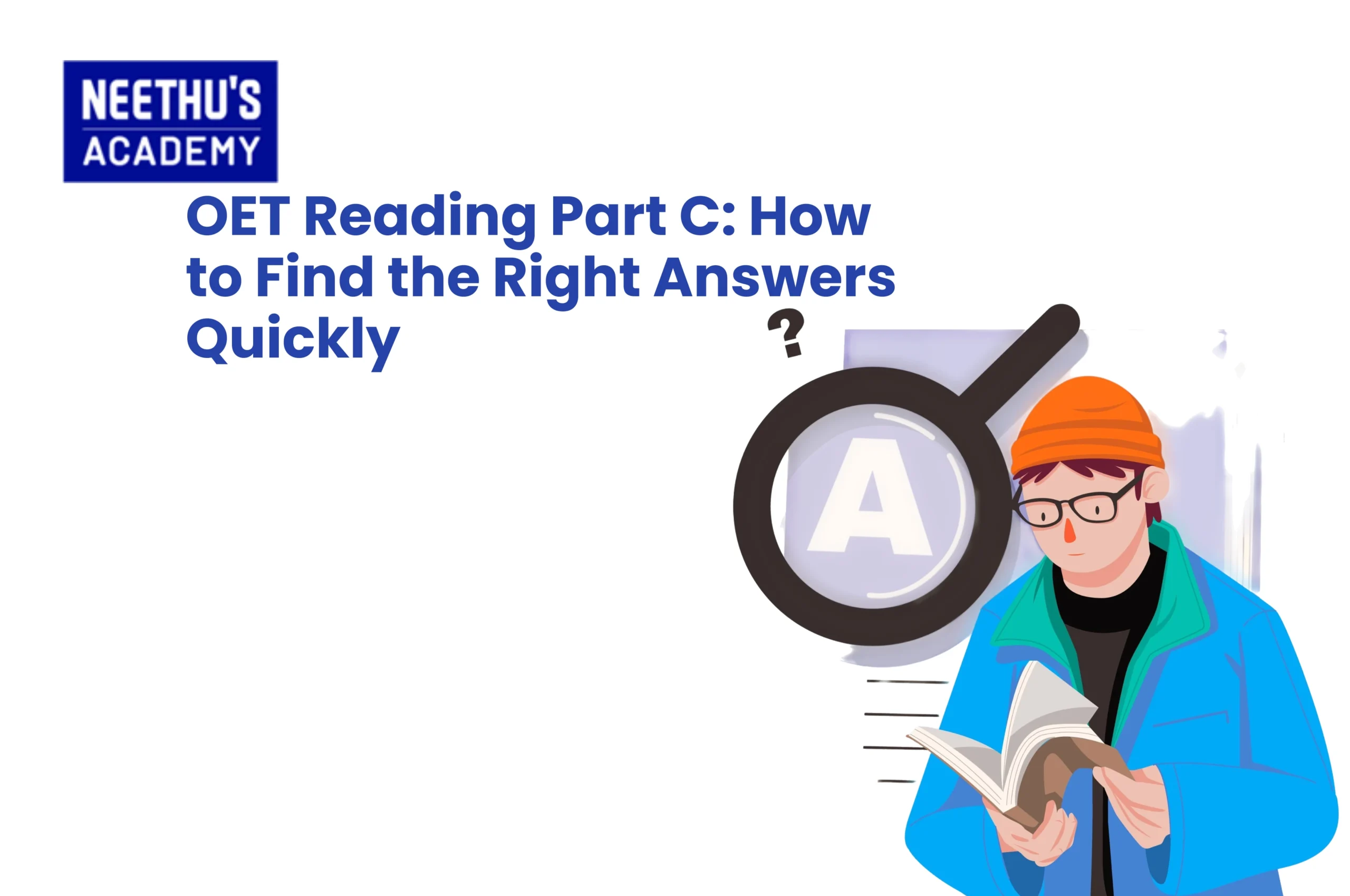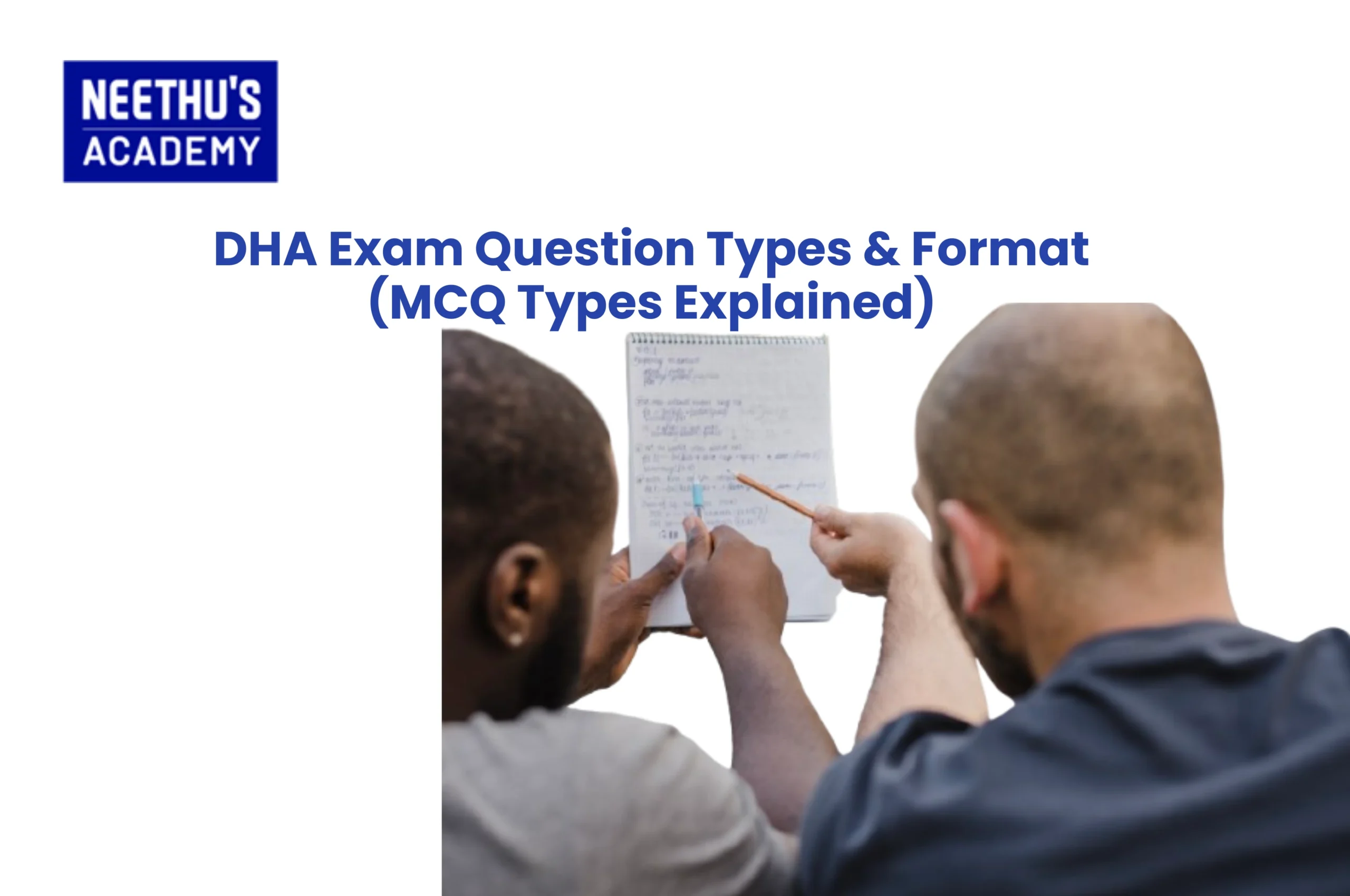The Occupational English Test is an entry pass for health care providers, including pharmacists, showing proof of proficiency in using English in…

OET Reading Part C: How to Find the Right Answers Quickly
OET Reading Part C is perhaps the most demanding part of the Occupational English Test, particularly for medical practitioners like doctors, nurses, and pharmacists. This part assesses your ability to comprehend opinions, attitudes, and the overall tone conveyed in professional medical texts. In contrast to recalling facts, Part C requires inference and interpretation, and candidates must determine what the writer implies as opposed to what they actually say.
Each passage is approximately 600–800 words in length, usually from healthcare journals, professional newsletters, or research studies. The idea is to measure how well you can comprehend intricate details and apply them in a healthcare setting — an essential skill for effective communication in actual medical settings.
If you’re preparing for OET reading for nurses, mastering Part C can make a big difference in your overall reading score. Let’s explore how to approach it strategically and efficiently.
Common Mistakes in Inference Questions
Inference questions form the foundation of Part C. Inference questions challenge your capacity to understand meaning that isn’t explicitly written but is implied through vocabulary, tone, and context. Most test-takers commit similar errors that can easily be prevented:
Mistake 1: Reading too quickly and overlooking the tone of the author.
Applicants tend to read too quickly and don’t see if the author is agreeing, criticising, or comparing. Tone words such as “however,” “in contrast,” or “on the other hand” usually signal a change in attitude.
Mistake 2: Paying attention to single words rather than the meaning of the sentence.
Don’t worry if you come across unfamiliar words. Concentrate on the general sense — context tends to make clear what a word means.
Mistake 3: Choosing an answer that repeats words from the passage.
The OET often includes distractor options that use similar vocabulary but different meaning. Always interpret what the author intends, not what’s directly repeated.
Mistake 4: Overthinking and changing answers.
Once you’ve chosen a logical answer based on evidence, trust it. Constantly switching options wastes time and lowers accuracy.
To deal with inference questions efficiently, have a practice of asking yourself, “What is the author trying to say here?” instead of “What words are used?”
Time Management Strategies
Time pressure is arguably the greatest challenge in OET Reading Part C. You have 45 minutes to finish Part B and C combined, with Part C typically consuming the greater chunk of your time.
Following are some OET reading tips to assist in time management:
- Spend approximately 30 minutes on Part C.
That leaves you with about 15 minutes per passage, or 1.5 minutes per question.
- Read the passage quickly at first.
Take 1–2 minutes to scan to grasp the overall theme, tone, and organisation. Identify paragraph subjects and mark where examples or arguments occur.
- Read the question before scanning for details.
It is helpful to know what the question is asking so that you can search for appropriate clues rather than reading all of the text.
- Don’t get stuck on one question.
If something doesn’t make sense, flag it and continue. You can come back later if there is time.
- Prioritise inference over vocabulary.
The aim isn’t to know every word but to grasp the overall message. Concentrate on ideas, not definitions.
Effective time management guarantees you to read purposefully and finish all questions without anxiety.
Vocabulary and Synonym Mapping
Vocabulary is of critical importance in OET Reading Part C. The test frequently paraphrases major ideas with synonyms or paraphrased expressions, so you need to map meanings instead of words.
For instance:
“Doctors are increasingly skeptical of the treatment” can be rewritten as “Medical professionals question the effectiveness of the therapy.”
The recognition that skeptical is the synonym for question is the point.
Hints to become a synonym mappertime master:
- Develop a personal glossary of medical and academic terms in practice.
- Practice on tone words (e.g., supportive, doubtful, critical, enthusiastic).
- Employ online programs or flashcards to revise synonyms.
- As you read, underline attitude or opinion words — they usually carry the key to the right answer.
- A solid vocabulary foundation will enable you to identify concealed meanings and filter out distractors swiftly.
Practice Approach Using Sample Papers
The most effective means of developing a grip on OET Reading Part C is through regular practice with actual sample papers. Practice real-style questions to grasp the test pattern, enhance speed, and gain confidence.
Here’s a step-by-step method for practicing effectively:
- Practice one passage at a time.
Read slowly and try to get the tone, argument flow, and inference. Don’t be in a hurry initially.
- Highlight keywords in every paragraph.
Mark important statements, opinions, and transitions. This aids in finding answers more quickly during timed practice.
- Study wrong answers.
Go over your errors at the conclusion of each practice test to see patterns — Are you reading tone incorrectly? Forgetting synonyms? Ruminating on distractors?
- Practice exam conditions weekly.
Complete full Reading Parts A, B, and C under timed conditions weekly to develop actual-test endurance.
- Use official OET practice materials.
Official sources give the best image of question difficulty and format.
By following this approach, you’ll notice steady improvement in both speed and accuracy over time.
Tracking Improvement Using Mock Tests
Mock tests are not just about scoring — they’re diagnostic tools to track your progress. Regular mock tests reveal how your reading comprehension, time management, and inference accuracy are improving.
To make the most of them:
- Record your scores after every test and note which question types cause difficulty.
- Compare performance trends every 2–3 weeks to gauge improvement.
- Identify persistent weaknesses like getting tone wrong or unable to find the main idea.
- Get expert feedback if available. Professional OET tutors can indicate where your reasoning falters.
For nurses, especially, understanding clinical context and author attitude becomes easier with repeated exposure to healthcare-related reading material. Over time, you’ll start predicting the writer’s intent faster — a crucial skill for success.
Conclusion
Breaking OET Reading Part C needs a combination of understanding, inference, and control over time. Through identifying tone, building vocabulary, and strategic practice, you can effortlessly select the correct answers confidently.
Don’t forget — it’s not speed reading but reading smarter. With consistent practice, active synonym mapping, and regular review of practice tests, you’ll see your comprehension and accuracy gradually improving.
Whether you’re preparing OET reading for nurses, doctors, or other professionals, staying disciplined in practice and analysis is the ultimate key to scoring high in Part C.
Frequently Asked Questions
There are 16 questions in total, 8 for each passage.
Most are multiple-choice inference questions focusing on the author’s attitude or opinion.
Approximately 15 minutes per passage is best.
They are primarily inference-based, i.e., you will have to understand implied meaning and not the face value facts.
Related Blogs
- All Posts
- OET
Among the several components of the OET, the Speaking sub-test is crucial and evaluates your proficiency not only in language but also…
Preparing for the Occupational English Test (OET) can be a game-changer for nurses aiming to advance their careers globally. At Neethu’s Academy,…
Course Enquiry
Latest Posts
- All Posts
- canada
- CBT
- DELF
- DHA
- French
- GENERAL
- German
- Haad
- IELTS
- IQN NEW ZEALAND
- MOH
- NCLEX-RN
- NHRA
- OET
- OSCE
- Pearson Vue
- PROMETRIC
- PTE
- TOEFL
- Back
- NCLEX - NGN
- Back
- OET FOR PHYSIOTHERAPIST
- OET FOR PHARMACIST
- OET FOR DOCTORS



